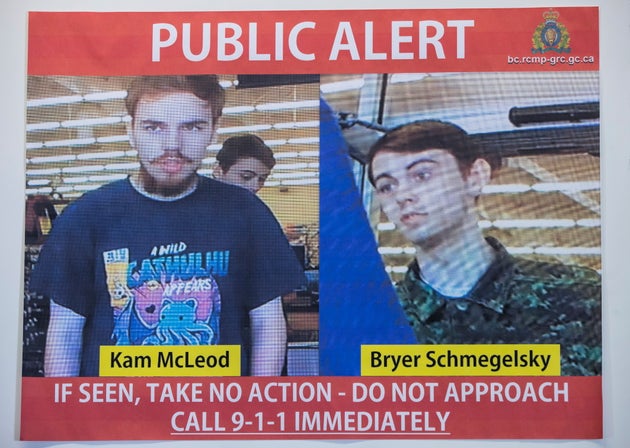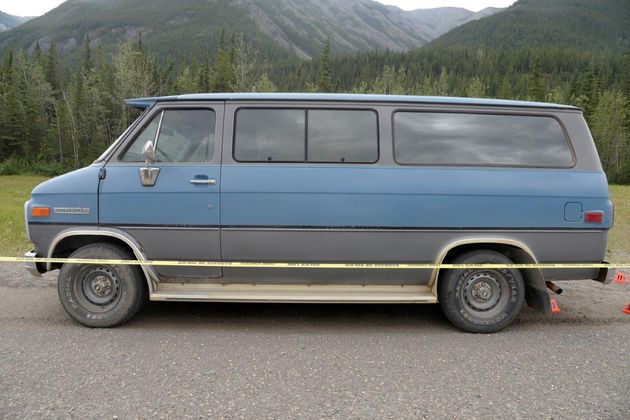This week a 2,000 mile manhunt ended in the grisly discovery of the bodies of two teenage boys, found in dense brush in northern Manitoba.
Though an autopsy is yet to confirm their identities, Canadian police are confident they are Kam McLeod, 19, and Bryer Schmegelsky, 18.
The teens themselves had originally been considered missing persons, but shortly before their deaths they had become fugitives suspected of murdering three people.

“We are confident that these are the bodies of the two suspects wanted in connection with the homicides in British Columbia,” Royal Canadian Mounted Police Assistant Commissioner Jane MacLatchy said earlier this week.
The pair set off from British Columbia three weeks ago, informing their families they were headed for Whitehorse in the Yukon in search for work.
During this time, McLeod and Schmegelsky became suspects in the fatal shootings of Australian Lucas Fowler, 23, and Chynna Deese, 24, of Charlotte, North Carolina, whose bodies were found July 15 along the Alaska Highway.


They were also charged with the second-degree murder in the death of Leonard Dyck, 64, a University of British Columbia lecturer whose body was found on July 19 along a highway in British Columbia, around 300 miles from where Fowler and Deese were killed.
A manhunt for the pair spread across three provinces and included tracking dogs, helicopters, boats, drones and the Canadian military. It also involved the canvassing of over 500 homes and building and following up on over 250 tip-offs.

McLeod and Schmegelsky themselves were first reported missing on July 19 after their Dodge pickup truck was found in flames near Dease Lake, British Columbia, around a mile away from Dyck’s body.
How did they die?
Police say they are investigating all possibilities including the possibility that the suspects might have drowned.
The bodies were found near Gillam, Manitoba — more than 2,000 miles from northern British Columbia, where they lived. They had been travelling in northern Saskatchewan in a grey 2011 Toyota Rav 4.
“This is like travelling from London to Moscow coupled with the fact that they were travelling in areas that are not highly populated,” British Columbia RCMP Assistant Commissioner Kevin Hackett said.
During the manhunt, police warned the public that both McLeod and Schmegelsky were considered dangerous and urged them not to approach them. Residents in York Landing, Manitoba, where two males matching the description of the men were seen, were told to “stay indoors as much as possible with their doors locked.”
A police helicopter had initially spotted a damaged boat along the Nelson River last week and a follow-up search in the area uncovered the items directly linked to the two in what Jane MacLatchy described as “very tough terrain,” which is made up of dense forest and is home to grizzly bears, polar bears, black bears and wolves.
She added: “This is a very large area we are looking at, very remote. It’s a very tough place to find somebody who doesn’t want to be found.”
Before their bodies were found, Sherman Kong, who teaches wilderness and extreme cold weather tactics, speculated the pair may well have succumbed to an animal attack, dehydration or other serious injury.
But he admitted that every year, people without formal training survive being lost in the wilderness.
“If we expect these two gentlemen are motivated, and even if they have a certain level of survival skills, that coupled with their intent on not being captured, can often be enough to allow someone to remain at large in the bush and survive longer,” Kong said.
What do we know about them?
McLeod and Schmegelsky grew up together on Vancouver Island and worked together at a local Walmart.
Before they were found, Schmegelsky’s father, Alan Schmegelsky, said he expected the nationwide manhunt to end in the death of his son, who he said was on “a suicide mission.”
Mr Schmegelsky told reporters he recalled accompanying his son to an army surplus eight months ago, where the teenager appeared enthusiastic about the Nazi artefacts. While Mr Schmegelsky says he didn’t think his son was a neo-Nazi, he did appear to find the paraphenalia “cool”.
Police are investigating a photograph of Nazi paraphernalia including a swastika armband and a Hitler Youth knife Schmegelsky allegedly sent to an online friend on the video-game network Steam.
Mr Schmegelsky, who is homeless, also shared a book he had written entitled Red Flagged, which he described as a novelisation of real and fictional incidents.
He said he was sharing the information to highlight how a “broken system” has shaped him and his son.
“My son and I have been treated like footballs. It’s time for some truth,” he said.
In his book, he wrote of his numerous arrests for harassment and custody battles for his son.
While the residents of northern British Columbia may be heaving a sigh of relief that the manhunt is over, the questions as to what inspired Schmegelsky and McLeod’s alleged killing spree are only just beginning.
“It’s huge to be able to hopefully give some people the opportunity to exhale and to hopefully go back to being normal and not be afraid of who is out in the woods,” said MacLatchy.
But while Gillam Mayor Dwayne Forman admitted his community was relieved the search was over, he said: “The closure for the victims’ families is far from over.”